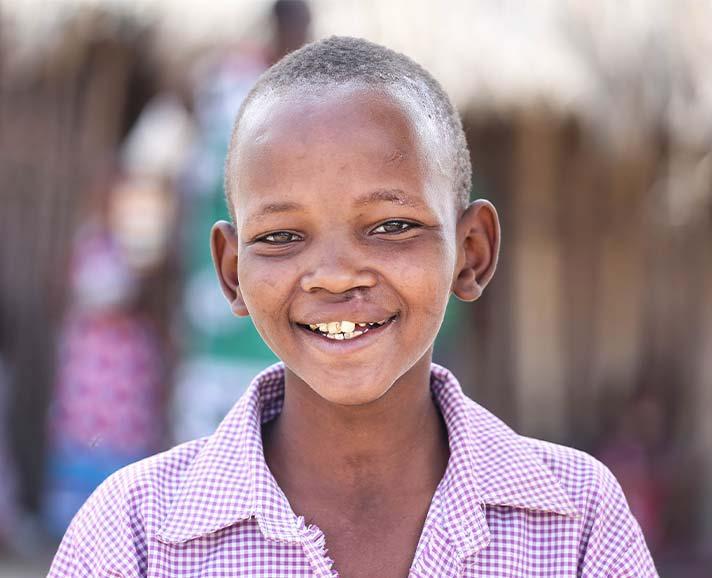
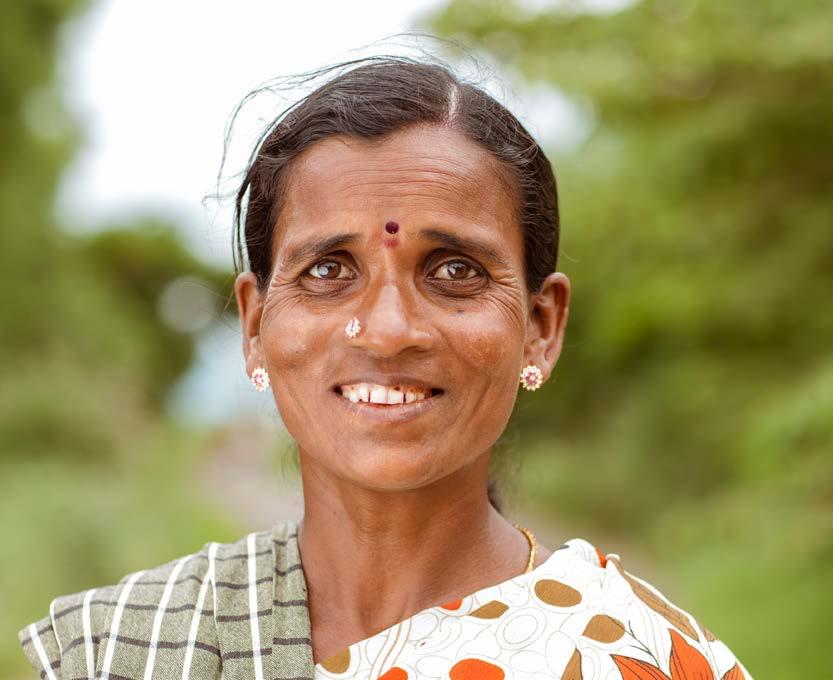



Advocacy priorities for the 4th United Nations
High–Level Meeting (UN HLM) on Noncommunicable diseases (NCDs) and mental health 2025

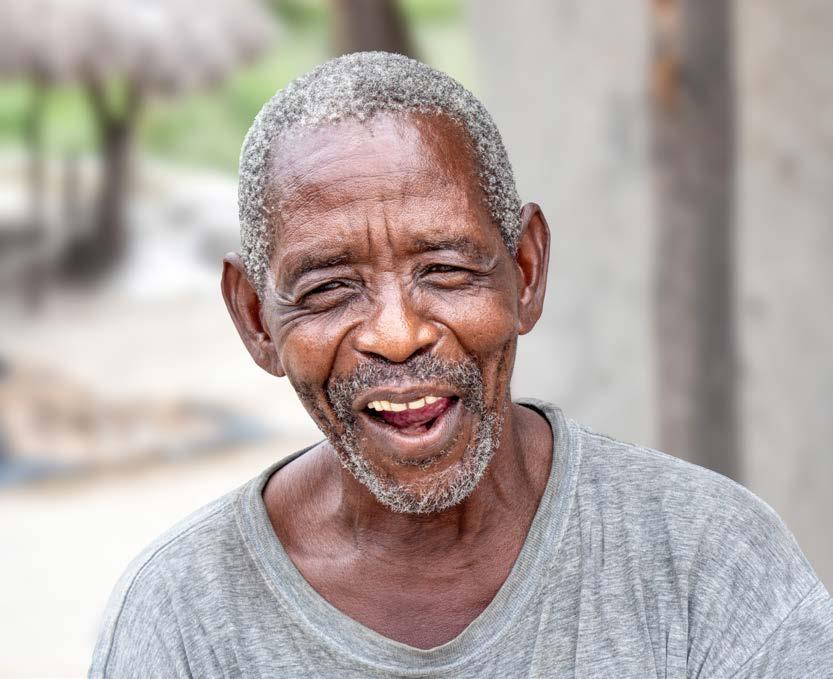

The fourth UN HLM on NCDs (HLM4) will take place on Thursday, 25 September 2025 in New York with the theme “Equity and Integration: Transforming lives and livelihoods through leadership and action on NCDs and mental health”. At this meeting, Heads of States and governments will assess the progress made since HLM3 in 2018. HLM4 will also set a vision to prevent and control NCDs towards 2030 and 2050 through a political declaration that will be negotiated by governments.
HLM4 presents a unique opportunity for governments to adopt a bold, action-oriented, and achievable agenda on NCDs, including oral health.
If advocates can voice the same key messages and recommendations to policymakers worldwide, we can amplify our impact and move closer to ensuring oral health is integrated into NCD and broader health policies and prioritized on national and global agendas.
In the lead-up to HLM4, FDI is mobilizing all stakeholders committed to advancing oral health by delivering coherent, aligned recommendations for governments. To support these efforts, targeted advocacy priorities have been developed in partnership with the International Association for Dental, Oral and Craniofacial Research (IADR).
•We call on governments to participate in HLM4, at the highest possible level, preferably at the level of Heads of State and Government
•We call on governments to adopt a whole-of-government, whole-of-society, health-in-allpolicies approach to the governance of NCDs.
•We call each government to develop and implement a national oral health policy aligned with the World Health Organization (WHO) Global Oral Health Action Plan (2023–2030)
• We call on governments to leverage the expertise and experience of all relevant stakeholders, including the private sector, to strengthen national responses to oral diseases and their risk factors.
•We call on governments to ensure the integration of essential, safe, quality, and affordable oral healthcare services into national UHC benefit packages
•We call on governments to invest in human resources for oral health in ways that are efficient, sustainable, and responsive to current and future population needs
•We call on governments to fully integrate oral health priorities into the agenda of the 3rd UN High-level Meeting on Universal Health Coverage (UHC) in 2027
•We call for the recognition of oral diseases, their risk factors, and the public health measures needed for their prevention and management in the Political Declaration of HLM4
• We call on governments to implement population-wide, evidence-based policies that promote oral health, including mass media campaigns highlighting the role of fluoride in preventing oral diseases
•We call on governments to address the role of sugars as a major contributor to unhealthy diets and poor oral health
•We call on governments to identify, manage, and mitigate industry interference that undermines oral health and NCD prevention efforts
•We call on governments to prioritize the phase down of dental amalgam use and adopt policies that promote sustainable practices in dentistry
• We call for investments in sustainable, resilient health systems, grounded in a primary health care approach
• We call for the integration of oral health education including on oral self-care practices into national UHC and PHC policies.
• We call for the timely and equitable availability of quality, affordable essential dental medicines and preparations, especially fluoride toothpaste
Account for and measure progress through effective surveillance and monitoring systems
• We call for the inclusion of specific targets related to oral health in the political declaration of HLM4
• We call on governments to establish national oral health surveillance systems using tools and methodologies aligned with the monitoring framework of the WHO Global Oral Health Action Plan (2023–2030).

Oral health is multi-faceted and includes the ability to speak, smile, smell, taste, touch, chew, swallow and convey a range of emotions through facial expressions with confidence and without pain, discomfort and disease of the craniofacial complex (head, face, and oral cavity).
Oral health means the health of the mouth. Irrespective of age, oral health is vital to general health and well-being.1
Oral diseases affect about 3.7 billion people globally. When combined, the estimated number of cases of oral diseases globally is about 1 billion higher than cases of all five main noncommunicable diseases (NCDs) –mental and neurological disorders, cardiovascular disease, diabetes mellitus, chronic respiratory diseases and cancers, making them one of the most prevalent NCDs.2
“Oral health is a basic human right…but one that is enjoyed by all too few”.
3.7 BILLION PEOPLE
Untreated tooth decay affects 2.5 billion people
Severe gum disease affects 1 billion people
Complete tooth loss affects 350 million people
Oral cancer affects 380,000 people
Oral diseases can be prevented, and treated in their early stages.

The main oral conditions contributing to the highest disease burden include caries in primary teeth and permanent teeth, complete tooth loss, severe gum (periodontal) disease, and various disorders affecting the teeth, tongue, and oral structures. However, many other conditions also require oral healthcare. These include:
• Lip and oral cavity cancer.
• Oral manifestations of systemic diseases (metabolic, allergic and immunologic diseases, including human immunodeficiency virus (HIV) infection).
• Oral mucosal diseases.
• Erosion and tooth wear (abrasion).
• Oral impacts of substance abuse, bulimia or anorexia nervosa.
• Noma.
• Congenital malformations of tooth structure.
• Oral viral, fungal, and bacterial infections.
• Trauma (including physical and chemical injuries) of the teeth, jawbones, and adjacent maxillofacial structures.
• Cysts and tumours of odontogenic and bone origin.
• Salivary gland diseases.
• Molar incisor hypomineralisation (MIH).
• Cleft lip and palate and other disturbances in the development and growth of oral structures.
These diseases and conditions are often underrepresented in the most widely cited global estimates of oral disease burden and their associated economic impact.2
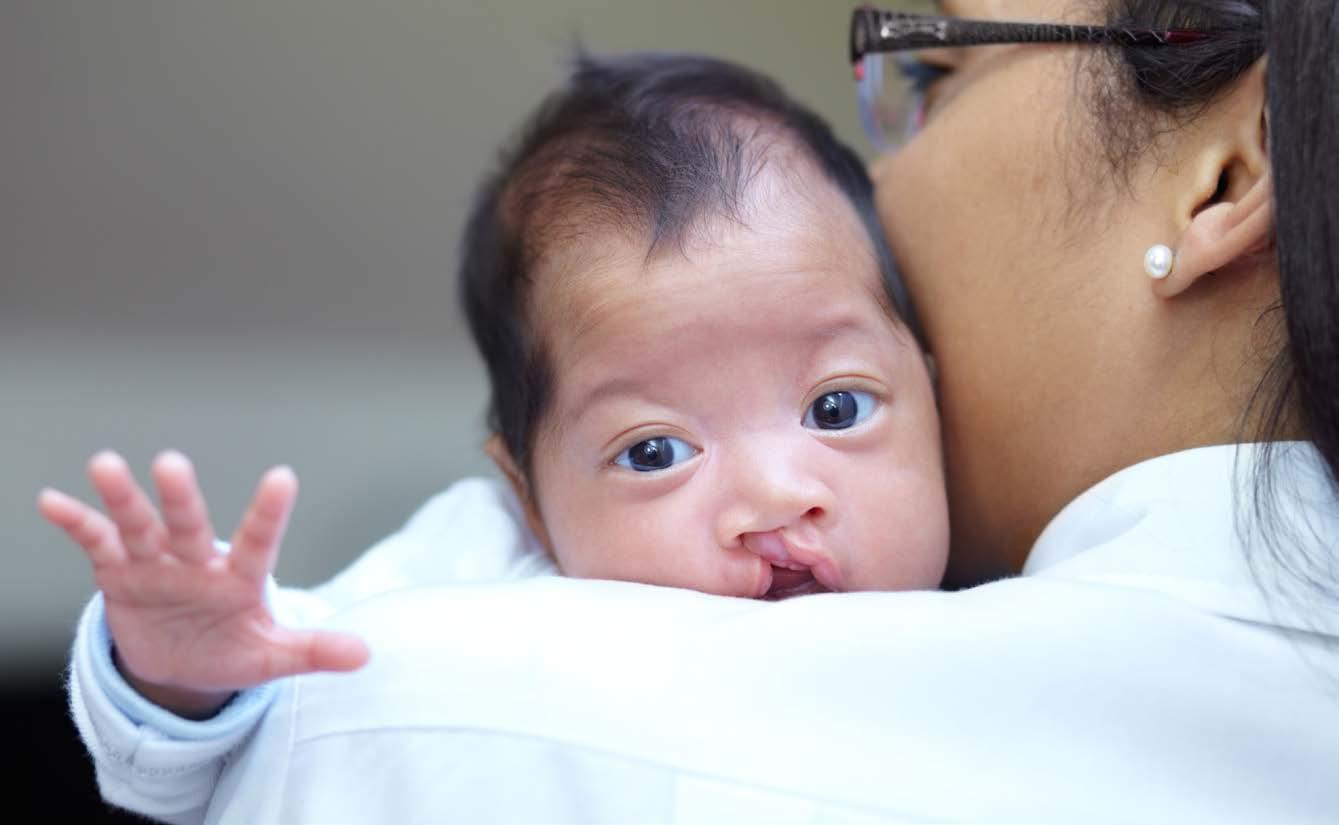

Oral diseases account for more years lost to disability than any other medical condition.4 They affect people of all ages causing loss of productivity, pain, disfigurement, severe illnesses, and in some cases, death.
Oral diseases are on the increase in all regions of the world
Health systems worldwide are struggling to meet oral healthcare needs as cases increase dramatically. Consequently, billions of people are living with unmet needs. Even in high-income countries where advancements in dental care have led to improved methods to ensure oral health, they have not benefited the entire population, and individuals and households with low income still suffer a significantly higher burden of disease.5
Oral diseases affect economic well-being significantly
The presence or absence of oral health has significant economic impact. Optimal oral health has been linked to employability, and increased productivity. In 2019, the economic burden imposed by oral diseases, was estimated at USD $710 billion. Treating the five main oral diseases cost US$387 billion while indirect costs such as productivity losses due to poor oral health amounted to USD $323 billion.6,7
Among unmet healthcare needs, oral health stands out
In countries grouped within the WHO Region of the Americas and the WHO Europe Region, only 38.4% and 36.5% of the population respectively are entitled to essential oral healthcare services.3 Consequently, oral conditions contribute significantly to the burden of unmet healthcare needs.
A study assessing common trends and challenges in financing, access, coverage and provision of oral healthcare in 31 European countries found that dental care is the most frequently forgone or unmet healthcare need due to financial reasons.8
Similarly, in the United States of America, the population reports much more difficulty in affording dental care services compared to any other type of healthcare service, including medical care, hospital care and even prescription drugs.6
Across countries grouped within the World Bank low-income grouping, only 10% of the population are entitled to these services.3
Globally, only 23% of the global population is entitled to essential oral healthcare services.


Research has shown that oral diseases do not occur in isolation; they commonly cluster with the other NCDs.4 This understanding presents a unique opportunity to offer leadership, evidence for, and subsequent education about, the importance and relevance of oral health to the achievement of overall health and well-being.
Oral diseases are also linked to a range of modifiable risk factors common to many NCDs. These include sugar consumption, tobacco use, alcohol use, poor hygiene, and the underlying health system, social and commercial determinants of health.9
Oral diseases share determinants and risk factors with other NCDs
COMMERCIAL DETERMINANTS
Include:
Obesogenic environments exposure to marketing of health-harming products, industry influence in policies affecting health, exposure to pollution, etc.
DETERMINANTS
Include:
Demographics (e.g. gender, age, ethnicity, poverty, religion), socioeconomic factors (e.g. education, social status or class), political factors (e.g. instability), violence and racism, stigma and discrimination, culture/tradition, literacy, etc.
HEALTH SYSTEM DETERMINANTS
Include:
Accessibility of NCD information and care, availability of health system resources for NCDsNCD workforce, medicines, equipment, affordability of NCD services etc.
Image Source: NCD ALLIANCE - From ideas to action, Accelerating the NCD response through health equity

The common risk factor approach acknowledges the role of certain causes in the burden of many chronic diseases, including oral diseases. It stresses that policies that address risk factors for oral illnesses address the very same risk factors associated with cardiovascular diseases, cancer, chronic respiratory diseases and diabetes – the leading cause of death globally.
This understanding should be a guiding principle for developing evidence-based, population-wide interventions that address social and commercial determinants of health to reduce disease burden.
The WHO NCD global monitoring framework tracks progress in preventing and controlling NCDs globally. It includes nine global targets and 25 indicators which WHO Member States can adopt to develop national NCD targets and indicators. Despite being one of the most prevalent NCDs globally, there are no indicators related to oral health specifically in this framework, and this remains a missed opportunity.
The Bangkok Declaration – No Health Without Oral Health, adopted at the inaugural WHO Global Oral Health Meeting in 2024, aims to address this issue. It calls for the inclusion of three reference targets related to oral health in the development of the renewed Global Monitoring Framework for NCDs.
1) By 2030, 80% of the global population is entitled to essential oral healthcare services as part of UHC.
2) By 2030, the combined global prevalence of the main oral diseases and conditions over the life course shows a relative reduction of 10%.
3) By 2030, 50% of countries implement measures aiming to reduce free sugars intake.
To achieve this vital recognition, the oral health community, along with NCD partners and the broader health professions, must advocate persistently to ensure that oral health is included in UHC and NCD policies and receives the acknowledgment it rightfully deserves at global, regional, and national levels.
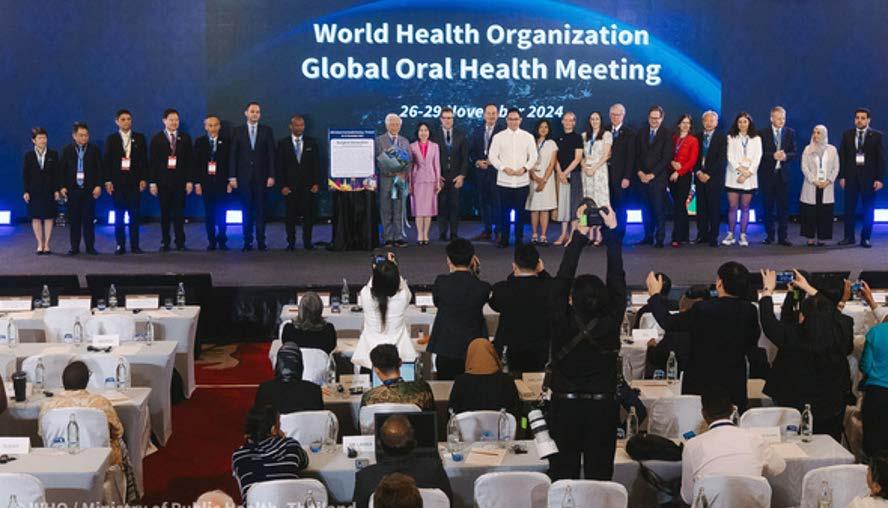

Third UN HLM on NCDs.
Launch of FDI Vision 2030: Delivering Optimal Oral Health for All
WHO Member States approve the landmark oral health resolution at the 148th Executive Board meeting (EB148).
The Resolution is unanimously adopted at the 74th World Health Assembly (WHA74).
A new section for dental preparations is added to the Model List of Essential Medicines.
WHA76 adopts the draft Global Oral Health Action Plan (2023–2030).
Second UN HLM on UHC. Oral diseases are recognised in the Political Declaration.
Release of “Redefining the noncommunicable diseases framework to a 6 x 6 approach: incorporating oral diseases and sugars”.
2019
FDI urges governments to integrate oral health into primary healthcare and UHC.
First UN HLM on UHC. Oral diseases are recognized in the Political Declaration.
Launch of the Lancet Series on Oral Health.
2021
2022
2023
Scope, modalities and format of the UN HLM on NCDs announced.
2025
Member States approve the new Global Strategy for Oral Health at the 75th World Health Assembly (WHA75).
WHO publishes the draft Global Oral Health Action Plan (2023–2030) for public consultation.
WHO launches the Global Oral Health Status Report, including the first-ever country Oral Health profiles.
WHA77 approves a list of evidencebased, cost-effective policies to promote oral diseases prevention.
WHO Global Oral Health Meeting and adoption of the Bangkok Declaration on Oral Health.
Luxembourg and St. Vincent and the Grenadines nominated as cofacilitators of the intergovernmental negotiation process for the UN HLM on NCDs.
UN Secretary General’s Progress report on NCDs released.
UN HLM on NCDs on Sept 25. Political Declaration expected to be adopted.

Oral health has remained in the spotlight in global policy discussions in recent years. Firstly, in 2019 and again in 2023, oral health was included in the Political Declarations of the first and second United Nations (UN) HighLevel Meetings on Universal Health Coverage (UHC). This inclusion represents an important commitment by governments to address oral diseases in national UHC programmes and plans.
Furthermore, the adoption of a landmark WHO Resolution of Oral Health in 2021 kickstarted a series of transformative policy developments, including the adoption of the Global Strategy on Oral Health in 2022, and the Global Oral Health Action Plan 2023–2030 in 2023. WHO also released the Global Oral Health Status Report, including the oral health profiles of its 194 Member States in 2022.
Additionally, in November 2024, WHO convened governments and key stakeholders for the first-ever WHO Global Oral Health Meeting to accelerate the implementation of the action plan. This historic event brought together representatives from 100 countries, including 12 health ministers, as well as delegates from 35 UN Agencies and non-State actors, totalling approximately 350 in-person participants. The meeting culminated in the adoption of the Bangkok Declaration – No Health Without Oral Health, which recognizes oral health as a fundamental human right, reaffirms its critical role within the NCD agenda, and highlights its significance in achieving Universal Health Coverage (UHC) by 2030.
Furthermore, it established the foundation for the Global Coalition on Oral Health bringing together Member States, UN agencies and non-State actors.
This important platform will track, and report commitments made by stakeholders to promote oral health, thereby enhancing accountability and inspiring further actions.
“Oral health is gaining momentum…but the oral health community must optimize the 2025 UNHLM on NCDs”
While ongoing political commitment to oral health is important, it is essential to translate these commitments into tangible actions to address the oral health needs of the 3.7 billion people who remain largely underserved. There is an urgent need to enhance the visibility of oral health, oral diseases and accelerate collaborative oral health research within both current and future NCD agendas.
Additionally, oral health interventions must prioritize marginalized population groups such as low-income earners; people living with disability; older people living alone or in care homes; people who are refugees, in prison or living in remote and rural communities; and people from minority and/or other socially marginalized groups.

All High-Level Meetings (UN HLMs) of the UN General Assembly represent an agreement to develop new cooperation measures, proffer solutions and strengthen stakeholders’ accountability on critical global issues. Furthermore, the political declarations adopted by the General Assembly of the UN are global agreements that provide strategic guidance for international cooperation in areas of interest.
The fourth United Nations (UN) High-Level Meeting on Noncommunicable Diseases (HLM4) will take place on 25 September 2025 in New York, under the theme: “Equity and Integration: Transforming lives and livelihoods through leadership and action on NCDs and mental health.” Heads of States and Governments will convene to review progress made since HLM3 in 2018 and to shape a renewed vision through a negotiated political declaration that will guide the prevention and control of NCDs through 2030 and towards 2050.
HLM4 represents a critical opportunity for governments to adopt a bold, action-oriented, and achievable agenda—one that recognizes oral health as an essential component of both NCD and broader health strategies.
The following are important opportunities to advocate for oral health and influence the outcomes of HLM4.
February 3–11
February 13–15
February
April 23–25
May 2
May 19–27
May–August
September 9–12
September 17–24
September 25
• 156th session of WHO Executive Board.
• WHO publishes the comprehensive baseline report of the WHO Global Oral Health Action Plan.
• 4 Global NCD Alliance Forum, Kigali, Rwanda
• The UN Secretary General published a report “Progress on the prevention and control of non-communicable diseases and the promotion of mental health and well-being”, including recommendations for governments.
• Resolution on the scope, modalities, format and organization of HLM4 approved.
• 2nd general meeting of the Global Coordination Mechanism on NCDs.
• 3rd WHO Symposium on Meaningful Engagement of people living with NCDs.
• High-Level multi-stakeholder hearing in preparation for HLM4, New York, USA.
• Release of the zero draft of the Political Declaration of HLM4 expected.
• Seventy-eighth World Health Assembly
• Intergovernmental negotiations of the Political Declaration.
• World Dental Congress 2025, Shanghai, China.
• NCD Alliance-led Global Week for Action on NCDs.
• HLM4, New York, USA.

To maximize impact, it is essential that advocates deliver unified messages and recommendations to policymakers worldwide. A collective voice will help ensure that oral health is fully integrated into both national and global health agendas.
In the lead-up to HLM4, FDI World Dental Federation (FDI) is mobilizing stakeholders across the oral health community around key advocacy priorities that were developed in collaboration with the International Association for Dental, Oral and Craniofacial Research (IADR).
The priorities build on established policy commitments, including the key recommendations and calls-to-action in the Bangkok Declaration – No Health Without Oral Health and seek to address the gaps highlighted in the baseline report of the WHO Global Oral Health Action Plan
At HLM4, oral diseases will be discussed as part of the broader NCD Agenda. Therefore, our advocacy priorities are structured around the five thematic areas outlined in the NCD Implementation Road Map 2023–2030: Engage, Invest, Align, Accelerate, and Account, and align with the recommendations of the WHO Global Oral Health Action Plan, approved by governments in May 2023.
The advocacy priorities assigned to each thematic action acknowledge the status of the global oral health targets approved by governments through the WHO Global Oral Health Action Plan in May 2023, and recommend new or reiterate existing commitments to address them.


By 2030, 80% of countries have an operational national oral health policy, strategy or action plan and dedicated staff for oral health at the Ministry of Health or other national governmental health agency.
• We call on governments to participate in HLM4, at the highest possible level, preferably at the level of Heads of State and Government
• We call on governments to adopt a whole-of-government, whole-of-society, health-in-all-policies approach to the governance of NCDs. This approach acknowledges the socio-cultural factors influencing oral health and the role of sectors outside of health in the global burden on oral diseases and NCDs. It will also shift the predominant focus of oral health away from technical interventions towards an approach based on the right to health, strengthened by robust oral health research, and consideration of the social, commercial and health system determinants of health.
• We call each government to develop and implement a national oral health policy aligned with the WHO Global Oral Health Action Plan, supported by dedicated and qualified staff to oversee its implementation.
• We call on governments to leverage the expertise and experience of all relevant stakeholders, including the private sector, to strengthen national responses to oral diseases and their risk factors.
By 2030, 80% of the global population is entitled to essential oral health care services.
• We call on governments to integrate essential, safe, quality, and affordable oral healthcare services into national UHC benefit packages, thereby reaffirming oral health as an essential component of the fundamental human right to health and a critical element of sustainable development.
• We call on governments to invest in human resources for oral health in ways that are efficient, sustainable, and responsive to current and future population needs. Oral health workforce planning should be included within national health workforce plans, policies and strategies.
• We call on governments to fully integrate oral health priorities into the agenda of the 3rd UN High-level Meeting on UHC in 2027 and in discussions on the post-2030 health agenda.
• We call on governments to prioritize and increase funding for oral health research to generate evidencebased solutions that address the global burden of oral diseases.
By 2030, the combined global prevalence of the main oral diseases and conditions over the life course shows a relative reduction of 10%.
By 2030, 50% of countries implement policy measures aiming to reduce free sugars intake.
• We emphasize that oral health education, including oral selfcare, risk factor awareness and effective oral hygiene practices can have significant impact in oral disease prevention, especially in communities where oral diseases are linked to cultural beliefs and practices.
• We call for the recognition of oral diseases, their risk factors, and the public health measures needed for their prevention and management in the Political Declaration of HLM4 due to their high and unequal burden.
• We call on governments to implement population-wide, evidence-based policies that promote oral health, including mass media campaigns highlighting the role of fluoride in preventing oral diseases
• We call on governments to address the role of sugars as a major contributor to unhealthy diets, which increase the incidence and prevalence of dental caries and exacerbates together with other risk factors like tobacco and alcohol use, the burden of other NCDs.
• We call on governments to identify, manage, and mitigate industry interference that undermines oral health and NCD prevention efforts, which was recognized as one of the major barriers in the NCD response at the 3rd UN HLM on NCDs in 2018.
• We call on governments prioritize the phase down of dental amalgam use and adopt policies that promote promote sustainable practices in dentistry
By 2030, 80% of countries have oral health care services generally available in primary health care facilities.
By 2030, 50% of countries include dental preparations listed in the WHO Model Lists of Essential Medicines in their national essential medicines list.
• We call for investment in resilient, research-informed primary health care systems to ensure equitable access to essential oral health services , with particular attention to the underserved and marginalized populations
• We call forthe integration of oral health education including on oral self-care practices within national UHC and PHC policies.
• We call for the timely and equitable access to quality, affordable essential dental medicines and preparations, especially fluoride toothpaste, aligned with the WHO Model Lists and supported by researchdriven innovations to enhance effectiveness and accessibility.
Account for and measure progress through effective surveillance and monitoring systems
By 2030, 80% of countries have a monitoring framework for the national oral health policy, strategy or action plan.
By 2030, 50% of countries have a national oral health research agenda focused on public health and population-based interventions.
• We call for the inclusion of the following reference targets related to oral health in the political declaration of HLM4, and the development of the renewed Global Monitoring Framework for NCDs:
By 2030, 80% of the global population is entitled to essential oral healthcare services as part of UHC (Overarching Global Target A).
By 2030, the combined global prevalence of the main oral diseases and conditions over the life course shows a relative reduction of 10% (Overarching Global Target B).
By 2030, 50% of countries implement measures aiming to reduce free sugars intake (Global Target 2.1).
By 2030, 50% of countries have a national oral health research agenda focused on public health and population-based interventions.
• We call on governments to establish national oral health surveillance systems using tools and methodologies aligned with the monitoring framework of the WHO Global Oral Health Action Plan, to track disease prevalence, enable evidence-based programme and policy development, access to quality services, and improve public health intervention effectiveness.

1. Glick M, Williams DM, et al. A new definition for oral health developed by the FDI World Dental Federation opens the door to a universal definition of oral health. International Dental Journal. 2016;66(6): 322–4. Accessed on 21.12.2022 via: https://doi.org/10.1111/idj.12294
2. WHO. Global oral health status report: towards universal health coverage for oral health by 2030. Geneva: World Health Organization; 2022. Licence: CC BY-NC-SA 3.0 IGO
3. Tracking progress on the implementation of the Global oral health action plan 2023–2030: baseline report. Geneva: World Health Organization; 2025. Licence: CC BY-NC-SA 3.0 IGO. Cataloguing-in-Publication (CIP) data. CIP data are available at https://iris.who.int
4. Global, regional, and national incidence, prevalence, and years lived with disability for 354 diseases and injuries for 195 countries and territories, 1990-2017: a systematic analysis for the Global Burden of Disease Study 2017. Lancet. 2018;392(10159):1789-858.
5. Glick M, Williams DM. FDI Vision 2030: Delivering Optimal Oral Health for All. Int Dent J. 2021 Feb;71(1):3-4. doi: 10.1016/j.identj.2020.12.026. Epub 2021 Jan 18. PMID: 33478782; PMCID: PMC9188664
6. The Economic Rationale for a Global Commitment to Invest in Oral Health. World Economic Forum White Paper. May 2024.
7. Global, Regional, and Country-Level Economic Impacts of Oral Conditions in 2019. M. Jevdjevic and S. Listl. Journal of Dental Research 2025 104:1, 17-21
8. Winkelmann J, Gómez Rossi J, van Ginneken E. Oral health care in Europe: Financing, access and provision. Health Systems in Transition, 2022; 24(2): pp. 1–169.
9. Oral Health – key facts. November 2024. Accessible via https://www.who.int/news-room/fact-sheets/ detail/oralhealth#:~:text=Oral%20diseases%20are%20caused%20by,underlying%20social%20and%20 commercial%20determinants.
10. Kickbusch I, Nikogosian H, Kazatchkine M, Kökény M, A Guide To Global Health Diplomacy Better health – improved global solidarity – more equity. Global Health Centre Graduate Institute of International and Development Studies. 2021 Accessed on 21.12.2022 via https://www.graduateinstitute.ch/sites/internet/ files/2021-02/GHC-Guide.pd